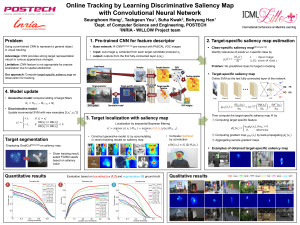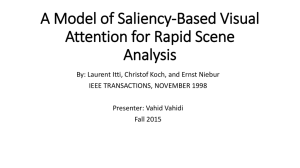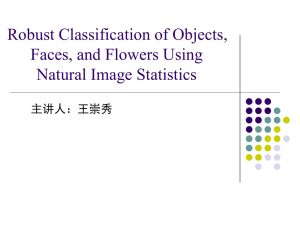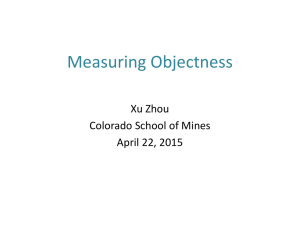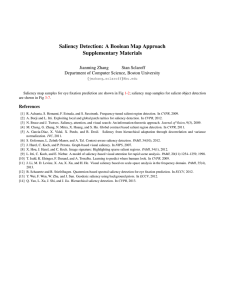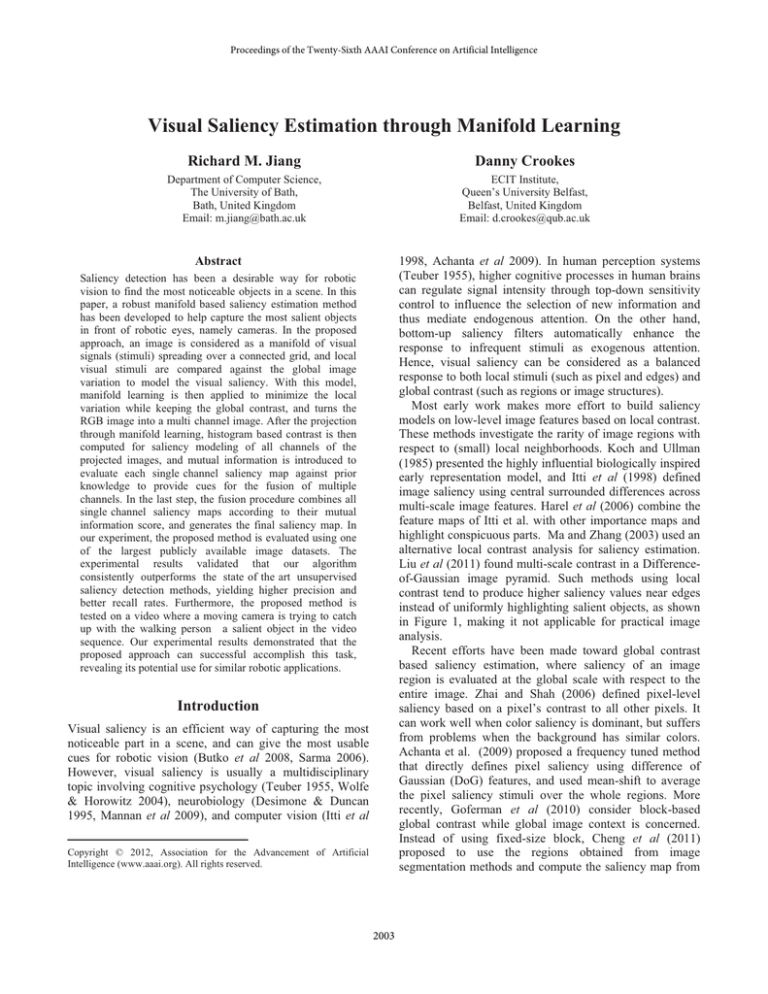
Proceedings of the Twenty-Sixth AAAI Conference on Artificial Intelligence
Visual Saliency Estimation through Manifold Learning
Richard M. Jiang
Danny Crookes
Department of Computer Science,
The University of Bath,
Bath, United Kingdom
Email: m.jiang@bath.ac.uk
ECIT Institute,
Queen’s University Belfast,
Belfast, United Kingdom
Email: d.crookes@qub.ac.uk
1998, Achanta et al 2009). In human perception systems
(Teuber 1955), higher cognitive processes in human brains
can regulate signal intensity through top-down sensitivity
control to influence the selection of new information and
thus mediate endogenous attention. On the other hand,
bottom-up saliency filters automatically enhance the
response to infrequent stimuli as exogenous attention.
Hence, visual saliency can be considered as a balanced
response to both local stimuli (such as pixel and edges) and
global contrast (such as regions or image structures).
Most early work makes more effort to build saliency
models on low-level image features based on local contrast.
These methods investigate the rarity of image regions with
respect to (small) local neighborhoods. Koch and Ullman
(1985) presented the highly influential biologically inspired
early representation model, and Itti et al (1998) defined
image saliency using central surrounded differences across
multi-scale image features. Harel et al (2006) combine the
feature maps of Itti et al. with other importance maps and
highlight conspicuous parts. Ma and Zhang (2003) used an
alternative local contrast analysis for saliency estimation.
Liu et al (2011) found multi-scale contrast in a Differenceof-Gaussian image pyramid. Such methods using local
contrast tend to produce higher saliency values near edges
instead of uniformly highlighting salient objects, as shown
in Figure 1, making it not applicable for practical image
analysis.
Recent efforts have been made toward global contrast
based saliency estimation, where saliency of an image
region is evaluated at the global scale with respect to the
entire image. Zhai and Shah (2006) defined pixel-level
saliency based on a pixel’s contrast to all other pixels. It
can work well when color saliency is dominant, but suffers
from problems when the background has similar colors.
Achanta et al. (2009) proposed a frequency tuned method
that directly defines pixel saliency using difference of
Gaussian (DoG) features, and used mean-shift to average
the pixel saliency stimuli over the whole regions. More
recently, Goferman et al (2010) consider block-based
global contrast while global image context is concerned.
Instead of using fixed-size block, Cheng et al (2011)
proposed to use the regions obtained from image
segmentation methods and compute the saliency map from
Abstract
Saliency detection has been a desirable way for robotic
vision to find the most noticeable objects in a scene. In this
paper, a robust manifold based saliency estimation method
has been developed to help capture the most salient objects
in front of robotic eyes, namely cameras. In the proposed
approach, an image is considered as a manifold of visual
signals (stimuli) spreading over a connected grid, and local
visual stimuli are compared against the global image
variation to model the visual saliency. With this model,
manifold learning is then applied to minimize the local
variation while keeping the global contrast, and turns the
RGB image into a multi channel image. After the projection
through manifold learning, histogram based contrast is then
computed for saliency modeling of all channels of the
projected images, and mutual information is introduced to
evaluate each single channel saliency map against prior
knowledge to provide cues for the fusion of multiple
channels. In the last step, the fusion procedure combines all
single channel saliency maps according to their mutual
information score, and generates the final saliency map. In
our experiment, the proposed method is evaluated using one
of the largest publicly available image datasets. The
experimental results validated that our algorithm
consistently outperforms the state of the art unsupervised
saliency detection methods, yielding higher precision and
better recall rates. Furthermore, the proposed method is
tested on a video where a moving camera is trying to catch
up with the walking person a salient object in the video
sequence. Our experimental results demonstrated that the
proposed approach can successful accomplish this task,
revealing its potential use for similar robotic applications.
Introduction
Visual saliency is an efficient way of capturing the most
noticeable part in a scene, and can give the most usable
cues for robotic vision (Butko et al 2008, Sarma 2006).
However, visual saliency is usually a multidisciplinary
topic involving cognitive psychology (Teuber 1955, Wolfe
& Horowitz 2004), neurobiology (Desimone & Duncan
1995, Mannan et al 2009), and computer vision (Itti et al
Copyright © 2012, Association for the Advancement of Artificial
Intelligence (www.aaai.org). All rights reserved.
2003
pertain to a stimulus in the visual field and combines these
features into a single topographical ’saliency map’. In the
retina, photoreceptors, horizontal, and bipolar cells are the
processing elements for edge extraction. After visual input
is passed through a series of these cells, edge information is
delivered to the visual cortex. In addition, a neural circuit in
the retina creates opponent cells which receive inhibitory
and excitory responses from various cones in the eye.
These systems combine with further processing in the
lateral geniculate nucleus (LGN), which plays a role in
detecting shape and pattern information such as symmetry,
as a preprocessor for the visual cortex to find a saliency
region. Hence, saliency can be considered as a biological
response to various stimuli.
In this paper, we consider the saliency originating from
the global image structure. The human visual perception
system usually ignores noise-like ephemeral or evanescent
stimuli. Instead, more attention is paid to considerably
longer-lasting stimuli that may have more energy. Bearing
this in mind, obviously, a structure-aware saliency could be
locally salient (e.g. a sharp contrast), and on the other hand,
globally consistent in comparison with other evanescent
stimuli. To attain this purpose, we introduce a manifoldbased learning scheme to emulate this biological process.
Considering an image as a set of pixel signals {xi}
distributed on the manifold over a 2D grid, as shown in
Fig.2, the saliency computation will naturally tend to
minimize the local stimuli and maximize the long-range
stimuli. This means we need to pull neighboring pixels
together while keeping their long-range contrast that stands
for salient image structures.
Given that we have input signals {xi} their connectivity
graph matrix S can be computed as,
­ 1 , r* r* 2 H
°
i
j
(1)
Sij ®
°̄0 ,
otherwise.
Here, ||.|| is the Frobenius norm, S is a similarity matrix, ri
and rj denote the spatial location of two pixels, and ε
defines the radius of the local neighborhood that is
sufficiently small, and greater than zero. When ε is set to be
1.5, each pixel will have eight connected nearest neighbor
pixels, namely KNN=4.
To optimize the local connected stimuli against the
global image structure, we define an objective function to
project {xi} into {yi}, as follows:
2
(2)
arg min ¦ yi y j S ij
Fig.1 Saliency maps of a typical challenging case
computed by various state-of-art methods, and with our
proposed manifold learning approach. In the first row,
from the left to the right: Original image, ground truth, SR
(Hou & Zhang 2007), IT (Itti et al in 1998), GB (Harel et
al 2006) and MZ (Ma & Zhang 2003). In the second row:
LC (Zhai & Shah 2006), FT (Achanta et al 2009), CA
(Goferman et al. in 2010), HC & RC (Cheng et al 2011),
and our manifold approach.
the region-based global contrast. However, it has been
revealed (Cheng et al 2010) that producing a correct salient
map is sensitive to the size of regions, and a manual fine
tuning of the segmentation is a prerequisite for some
challenging images. In summary, it has been observed that
most global approaches depend on either regions from
image segmentation, or blocks with specified sizes.
While image structures at global scale are usually an
important factor for producing salient stimuli, in this paper
we present a novel approach for saliency modeling, namely
manifold based saliency estimation. In our approach, we
propose the balancing of local pixel-level stimuli with
global contrast, and learn long range salient stimuli through
unsupervised manifold learning, which provides a local-toglobal abstraction for further saliency detection.
In experiments, we extensively evaluated our methods on
publicly available benchmark data sets, and compared our
methods with several state-of-the-art saliency methods as
well as with manually produced ground truth annotations.
Our experiments show significant improvements over
previous methods in both precision and recall rates.
Encouragingly, our approach also provided a convenient
way for unsupervised saliency detection in video sequence.
Fig.1 demonstrates a typical challenging case (raised by
Goferman et al. in 2010) for all state-of-the-art approaches.
Our approach not only robustly detected the red leaf, but
also provided a drastic contrast between the foreground and
the background. With this advantage, the proposed
approach can easily be extended to robotic vision tasks,
such as salient object tracking.
W
ij
where
(3)
x y WT x
Here W is the projection matrix. The above target function
is similar to the Laplaican Eigenmap one (Belkin & Niyogi
2003), a typical manifold learning approach. The only
difference is that instead of using the distance between xi
and xj, we use their spatial location to define the
connectivity matrix S from Eq.(1).
The objective function with the choice of symmetric
Saliency-Aware Manifold Learning
Nearly three decades ago, Koch and Ullman (1985)
proposed a theory to describe the underlying neural
mechanisms of vision and bottom-up saliency. They
posited that the human eye selects several features that
2004
weights Sij incurs a heavy penalty if two pixels xi and xj
within a small distance are mapped far apart with a large
distance ||yi-yj|| in their subspace projection. Therefore,
minimizing the expression in (2) is an attempt to ensure
that, if two pixels in the image, xi and xj, are “close” in term
of their location on the spatially connected manifold, their
projection yi and yj should then be close as well. Thus, this
strategy using Sij in Eq.(1) sets up a spatial confinement to
suppress local stimuli while leaving long-distance stimuli
as they are.
Following some simple algebraic steps, we can have,
Fig.2 Manifold-based image abstraction. From left to
right: Original image, terrain view of its red channel,
results after abstraction and its terrain.
1
2
¦ yi y j Sij
2 ij
2
1
¦ W T xi W T x j Sij
2 ij
T
T
¦ij W T xi Sij xi W ¦ij W T xi Sij x j W
T
Fig.3 Manifold-based image abstraction with different
KNN. From left column to right: Original images, KNN =4,
KNN =8, KNN =16, KNN =24, and KNN =32.
T
W XLX W
where W is the data projection matrix, and
L
D S , with Dij
­¦ j S ij , i j
®
¯ 0, i z j
L is the Laplacian matrix. Then the problem becomes:
(4)
arg min W T XLX T W
W
Here, the Laplacian graph model is embedded to convert
the nonlinear problem into a linear problem.
Fig.2 illustrates the projection results for saliency
abstraction. The left one shows the image, in which the
pebbles look quite like a noisy- or texture-style scene. The
third one shows the manifold base saliency-targeted image
projection results. It can be seen that the salient yellow
candy is kept as global stimuli, and other local differences
among pebbles are drastically smoothed. Fig.2 also uses a
3D plot to show the comparison between the original image
in one (red) color channel and the abstraction result in the
primary projection channel. Obviously, manifold learning
provides a context-aware saliency preservation. This idea is
somewhat similar to the purpose of the method by
Goferman et al. in 2010, which compared the local block
against its global contrast, though our way is
mathematically different.
It is noted that in the proposed manifold learning, the
abstraction can be sensitive to the parameter ε or KNN,
which define how many nearest neighbors a pixel can have.
Fig.3 shows the comparison using different KNN from 4 to
32. We can see that the more neighbors are allowed, the
higher the local-global contrast could be. However, it may
blur the edges to smooth using more neighbors for each
pixel. In this paper, we typically set KNN as 8.
(a) The computation of histogram saliency φk. From left
to right: Single-channel 1D histogram; Computed bin’s
histogram saliency; Original image and one of its singlechannel saliency maps.
(b) Single-channel saliency map estimation in each
channel (10 channels listed).
Histogram-based Saliency Detection
(c) Priori map and the fusion result
Through the above manifold learning, an RGB image is
actually turned into a multi-channel image with up to more
than ten projected dimensions. The multiplication of
Fig.4 Saliency estimation per channel and the fusion of all
results using mutual information.
2005
channels can give the saliency detection scheme more
information and thus better accuracy. On the other hand, it
also results in more data to process.
As it has been discussed, global contrast [Achanta et al
2009] has been proved to give better accuracy than most
local methods. Cheng et al (2011) proposed to model the
saliency using a 3D histogram from Lab color channels.
With its simplicity and reliability, we choose to use
histogram contrast estimation for our saliency detection.
However, given the number of dimensions after manifold
projection, it is unlikely to put all channels together, since
the number of histogram bins will be overwhelming.
Instead, in our proposed scheme, we first estimate saliency
per channel, and then combine them together to attain
robust saliency estimation.
It is noticed that region-based saliency estimation (Cheng
et al 2011) has attained great success in its recall-precision
performance. However, as has been shown, this technique
needs a manual-tuning of image segmentation, making it
not applicable for robotic applications, where automatic
detection is the primary concern.
In mathematics, the pixel-level saliency can be
formulated by the contrast between histogram bins,
(5)
Mk
k j Nj
Fig.5 Examples of single-channel saliency estimation
and their fusion. The last two columns are the original
images and the fusion results, and the foregoing columns
are the estimated single channel saliency maps. (In the
figure, ‘jet’ colormap was applied to make the saliency
contrast visually easy to evaluate).
¦
j
where, Nj is the number of pixels in the j-th bin, and φk is
the initially computed saliency for the k-th bin. Fig.4-a)
shows the procedure for computing the histogram saliency
φk. First, the histogram Nj is computed, as shown on the
left. Then with the above equation, φk is obtained
accordingly, as shown on the right.
With the above simple scheme, we can easily obtain the
initial saliency map for each channel of a projected image.
Fig.4-b) shows an example, where the saliency maps are
computed for the first ten channels, respectively. However,
it is obvious these initial estimations are far from accurate.
We then introduce a mutual information scheme to refine
these initial results by a weighted fusion procedure.
vectors, namely Sk and Pr, and we compute their MI score
as:
(6)
H Sk , Pr ¦ p hSk , hPr log hSk , hPr
b
^
`
Here, hX stands for the histogram of the variable X. Details
on MI can be found in the survey by Verdu et al (1999). In
Fig.4-b), the computed MI score is tagged on every singlechannel saliency map.
Once we have the estimated mutual score, it becomes
simple to fuse the multi-channel saliency map, which can
be expressed as a weighted totaling,
(7)
STotal x, y ¦ H Sk , Pr Sk x, y k
Fusion of Multiple Channels
where, (x, y) stands for the coordinates of a pixel in its
saliency map.
The right image in Fig.4-c) shows the final added-up
saliency map for the original image in the middle. In Fig.5,
several more examples are demonstrated. We can see that
in comparison to single-channel saliency maps, the fusion
results computed by the proposed fusion scheme have been
greatly enhanced, and a robust performance is attained.
To attain an accurate and coherent fusion of multiple
channels, we introduce mutual information to weight the
initially estimated saliency maps. Basically, we can assume
a priori knowledge that human perception always pays
attention to the objects around the center of a scene. We
can model this using a centered anisotropic Gaussian
distribution, as shown in the left image in Fig.4-c). With
this expectation, we can then evaluate the initial estimation
against this priori map.
Mutual information (MI) can be considered a statistic for
assessing independence between a pair of variables, and has
a well-specified asymptotic distribution. To calculate the
MI score between a saliency map in Fig.4-a) and the priori
map in Fig.4-b), we first convert these two 2D matrices into
Experimental Comparison
In our experiment, we evaluated our approach on the
publicly available database provided by Achanta et al
(2009). To the best of our knowledge, this database is the
largest of its kind, and has ground truth in the form of
2006
in 2011. This RC method was shown (Cheng et al 2011) to
attain high precision, but sometime it depends on the user’s
interactive tuning of its image segmentation procedure,
which is sensitive in producing correct regions for saliency
estimation. It may fit well for image editing applications
but not so useful for robotic applications. In the later case,
unsupervised saliency estimation is required.
Fig.6 demonstrates the qualitative comparison results on
several challenging cases that most existing methods failed
to extract the correct saliency map from. We can clearly see
that the proposed manifold-based method can robustly
tackle these cases with high saliency contrast ratio between
the salient regions and the background.
Fig.7 shows the statistical results of precision-recall
curves. The curves were obtained in the same way as
Achanta (2009) proposed, where naïve thresholding was
applied from 0 to 255 to obtain successively a list of both
precision and recall rates when subtracting the binarized
saliency maps with their corresponded ground truth. The
experimental results clearly validate that our proposed
approach (the red curve in Fig.7) has consistently
outperformed all state-of-the-art approaches. With the
proposed manifold learning and fusion scheme, we can see
that a robust unsupervised saliency estimation scheme has
been successfully developed and validated.
Additional Experimental Results
In most robotic vision applications, the input signals are
consecutive frames from the video camera. This means a
robust saliency detector needs to tackle video-style visual
Fig.6 Visual comparison of saliency maps. From left to
right columns: 1) original image, 2) ground truth, 3) FT
(Achanta et al 2009), 4) CA (Goferman et al 2010), 5)
HC(Cheng et al 2011), 6) RC(Cheng et al 2011), and our
manifold-based method. It can be observed that our
algorithm can robustly tackle challenging cases which
most algorithms failed to tackle.
accurate human-marked labels for salient regions.
The average size of test images in the dataset is around
400×300 pixels each. Our system was implemented in
MATLAB, on a PC with 2GB RAM and a 3GHz dual-core
CPU. The test images were input by the standard interface
provided by the MATLAB library.
We compared the proposed method with eight state-ofthe-art saliency detection methods, namely: 1) SR (Hou &
Zhang 2007); 2) IT (Itti et al in 1998); 3) GB (Harel et al
2006); 4) MZ (Ma & Zhang 2003); 5) LC (Zhai & Shah
2006); 6) FT (Achanta et al 2009); 7) CA (Goferman et al
2010); 8) HC(Cheng et al 2011). While our algorithm is
implemented in MATLAB, the average computation time
for each image is around 1.056 seconds.
For the other methods, we took the authors’ published
results provided from Cheng et al 2011 and Achanta et al
2009 for our evaluation and comparison. We did not
compare our approach with the RC method by Cheng et al
Fig.7 Precision-recall curves for naive thresholding of
saliency maps using 1000 publicly available benchmark
images. Our method is compared with 1) SR (Hou &
Zhang 2007); 2) IT (Itti et al in 1998); 3) GB (Harel et al
2006); 4) MZ (Ma & Zhang 2003); 5) LC (Zhai & Shah
2006); 6) FT (Achanta et al 2009); 7) CA (Goferman et
al 2010) ; 8) HC(Cheng et al 2011). It is shown that the
proposed approach can consistently outperform the stateof-art approaches.
2007
Fig.8 Video saliency detection in the challenging camera-moving case. In the test video, the camera tracks the person
walking in front of the textured fence from the left to the right. From the test, the detected saliency is stably allocated on the
walking person, though the background is moving in the reverse direction of camera motion.
data. A challenging problem for many robotic tracking
applications is the demand to analyze the scene instantly
with a moving background, while the camera equipped on a
robot usually moves arbitrarily due to the random motion of
the robot.
For most state-of-the-art computer vision approaches, it
is still very tricky to detect a moving object consistently in
front of an arbitrary moving background. Conventional
approaches such as GMM-based motion segmentation and
optical flow can easily fail in these challenging cases. They
are also compute-intensive, making it hard to be
implemented on embedding systems that can be
accommodated on robots. Instead, saliency detection can
instantly capture the salient object with no need for pixellevel motion field analysis or motion segmentation, making
it a promising solution provided for robotic vision to
overcome this sort of challenge.
While our initial evaluation on static images has
demonstrated the advantages of our approach, we have
further tested our approach on test videos. Fig.8 shows our
estimated saliency maps of consecutive frames in a test
video, where the camera tracks the person walking in front
of the textured wooden fence from the left to the right.
As shown in Fig.6, our algorithm can easily detect the
walking person across the whole video shot. In all 180
frames, the algorithm detected the person in all frames with
no object-level false positive detection. Such unsupervised
salient object detection can greatly facilitate the robotic
vision to cope with various tasks in practical applications.
Conclusion
In conclusion, a robust manifold-based saliency estimation
method has been proposed for robotic vision to capture the
most salient objects in the observed scenes. In the proposed
approach, an image is considered as a manifold of visual
signals (stimuli) spreading over a connected grid, and
projected into a multi-channel format through manifold
learning. Histogram-based saliency estimation is then
applied to extract the saliency map for each single channel,
respectively, and a fusion scheme based on mutual
information is introduced to combine all single-channel
saliency maps together according to their mutual
information score. In our experiment, the proposed method
is evaluated using a well-known large image dataset. The
experimental results validated that our algorithm attained
the best prevision and recall rates among several state-ofart saliency detection methods. Furthermore, the proposed
method has been demonstrated on a test video to show its
potential use for robotic applications, such as tracking a
moving target in an arbitrary scene while the camera is
moving with a robot. The experimental results show that
the proposed approach can successfully accomplish this
sort of tasks, revealing its potential use for similar robotic
applications.
2008
2011.
Y. F. Ma and H. J. Zhang. Contrast based image attention
analysis by using fuzzy growing. In ACM Multimedia, pages
374 381, 2003.
S. K. Mannan, C. Kennard, and M. Husain. The role of visual
salience in directing eye movements in visual object agnosia.
Current biology, 19(6):247 248, 2009.
J. Reynolds and R. Desimone. Interacting roles of attention and
visual salience in v4. Neuron, 37(5):853 863, 2003.
C. Rother, V. Kolmogorov, and A. Blake. “Grabcut” Interactive
foreground extraction using iterated graph cuts. ACM Trans.
Graph., 23(3):309 314, 2004.
U. Rutishauser, D. Walther, C. Koch, and P. Perona. Is bottom up
attention useful for object recognition? In CVPR, pages 37 44,
2004.
Subramonia Sarma, Yoonsuck Choe. 2006. Salience in
orientation filter response measured as suspicious coincidence in
natural images. in Proceedings of AAAI 2006 Volume 1.
H. Teuber. Physiological psychology. Annual Review of
Psychology, 6(1):267 296, 1955.
A. M. Triesman and G. Gelade. A feature integration theory of
attention. Cognitive Psychology, 12(1):97 136, 1980.
J. M. Wolfe and T. S. Horowitz. What attributes guide the
deployment of visual attention and how do they do it? Nature
Reviews Neuroscience, pages 5:1 7, 2004.
Y. Zhai and M. Shah. Visual attention detection in video
sequences using spatiotemporal cues. In ACM Multimedia, pages
815 824, 2006.
S. Verdu, S. W. McLaughlin, editors. Information Theory: 50
Years of Discovery. IEEE Press, 1999.
References
R. Achanta, S. Hemami, F. Estrada, and S. Susstrunk. Frequency
tuned salient region detection. In CVPR, pages 1597 1604, 2009.
M. Belkin and P. Niyogi, “Laplacian Eigenmaps for
Dimensionality Reduction and Data Representation,” Neural
Computation, vol. 15, no. 6, pp. 1373 1396, 2003.
Butko, N.J., Zhang, L. Cottrell, G.W. and Movellan, J.R. (2008)
Visual saliency model for robot cameras. In International
Conference on Robotics and Automation (ICRA 2008).
Ming Ming Cheng, Guo Xin Zhang, Niloy J. Mitra, Xiaolei
Huang, Shi Min Hu. Global Contrast based Salient Region
Detection. IEEE CVPR, p. 409 416, Colorado Springs, USA, June
21 23, 2011. http://cg.cs.tsinghua.edu.cn/people/~cmm/saliency/
R. Desimone and J. Duncan. Neural mechanisms of selective
visual attention. Annual review of neuroscience, 18(1):193 222,
1995.
S. Goferman, L. Zelnik Manor, and A. Tal. Context aware
saliency detection. In CVPR, 2010.
J. Harel, C. Koch, and P. Perona. Graph based visual saliency. In
NIPS, pages 545 552, 2006.
X. Hou and L. Zhang. Saliency detection: A spectral residual
approach. In CVPR, pages 1 8, 2007.
L. Itti, C. Koch, and E. Niebur. A model of saliency based visual
attention for rapid scene analysis. IEEE TPAMI, 20(11):1254
1259, 1998.
C. Koch and S. Ullman. Shifts in selective visual attention:
towards the underlying neural circuitry. Human Neurbiology,
4:219 227, 1985.
T. Liu, Z. Yuan, J. Sun, J.Wang, N. Zheng, T. X., and S. H.Y.
Learning to detect a salient object. IEEE TPAMI, 33(2):353 367,
2009



